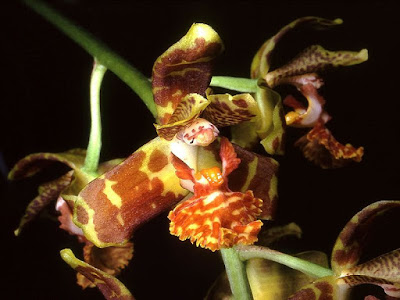Rudolfiella floribunda is native to Colombia, Ecuador and Peru. In Ecuador, this plant is found in the lower east of the Andes in the province of Morona-Santiago....
Rudolfiella floribunda also called as The Floriferous Rudolfiella, Bifrenaria floribunda, Bifrenaria saxicola, Lindleyella floribunda, Lindleyella saxicola, Rudolfiella saxicola, Schlechterella floribunda, Schlechterella saxicola, is a species of the genus Rudolfiella. This species was described by Frederico Carlos Hoehne in 1953.
IDENTIFY RUDOLFIELLA FLORIBUNDA
Rudolfiella floribunda is native to Colombia, Ecuador and Peru. In Ecuador, this plant is found in the lower east of the Andes in the province of Morona-Santiago. In this region, the plant grows on trees and rocks in a wet tropical forest at an altitude of around 600 m. Plants are also found near the borders of Ecuador and Peru. In Peru, in the Loreto department, plants are found between Balsapuerto and Moyobamba growing on trees at an altitude of around 600-1200 m and near Bagua in the Amazonas department, where the plants grow along the Río Maranon at an altitude of 650 m.
It is a small sized, hot to warm growing, caespitose lithophyte and epiphyte, which growing up to 45 cm in height, with ovoid-pyriform, lightly sulcate, glabrous, 2.0-5.0 cm long and 3.5 cm wide pseudobulbs subtended by several dry basal, papery bracts with a single elliptic-lanceolate, attenuate, acute, plicate, subcoriaceous, rigid, 40-45 cm long leaf with an elongate, terete petiole.
The Floriferous Rudolfiella blooms on a lateral, 36 cm long, very lax, several flowered, racemose inflorescence with 3 tubular scarious bracts on the lower half and minute floral bracts that is longer than the leaf and arising on a mature pseudobulb with successive opening flowers occurring in the summer in cultivation and winter in nature. The flowers have a diameter of 3.2 cm. Outer petals are light brown-yellow with large brown spots. The inner whorls are dark yellow with small transverse red-brown spots. The lip is light yellow, transversely striped brown-red, and at the base and on the thickening there are stripes in a light brown color. The spine is white and yellow with pink spots, and the pollen chamber cover is light yellow with 2-3 pink spots.
RUDOLFIELLA FLORIBUNDA CARE AND CULTURE
Cultural information should only be used as a guide, and should be to be adapted to suit you. Your physical location; where you grow your plants, how much time you have to devote to their care, and many other factors, will need to be taken into account. Only then can you decide on the cultural methods that best suit you and your plants.
Light:
Rudolfiella floribunda needs a light level of 20000-30000 lux. Growing conditions should be clear, but the light should be slightly filtered or dispersed, and the plants should not be exposed to the direct sunlight of the midday sun. You need to ensure constant strong air movement.
Temperature:
It is a thermophilic plant. The average day temperature during the whole year is 29-31 ° C, night 18-22 ° C, which gives a daily amplitude of 9-10 ° C.
Humidity:
The Floriferous Rudolfiella needs the humidity of around 80% throughout the year.
Substrate, growing media and repotting:
Rudolfiella floribunda are usually planted into pots or baskets that have a very good drainage of water, using a loose, fast-drying substrate. As a substrate, small pieces of tree fern are recommended, which slower to decompose.
Some breeders recommend growing these plants in a medium consisting of only a few pieces of tree ferns, but materials such as perlite or chopped sphagnum moss are often added to the substrate, which help to retain moisture and at the same time provide air access. Wood charcoal is also often added to ensure the air permeability of the substrate and protection against acidification.
If the plant has already outgrown the pot and the substrate has not yet decomposed, the plant can be easily repotted into a larger container, supplementing only the substrate around the roots. If the substrate has decomposed and the plant needs to be repotted, this should be done at the start of new root growth. This allows plants to quickly root themselves, preventing weakness.
Watering:
In the natural environment, rainfall is medium to strong for most of the year with a drier period from late autumn to early spring. The plants in cultivation should be intensively watered from spring to autumn with a slight drying of the substrate between subsequent waterings.
Fertilizer:
The plants should be fertilized every week 1/4-1/2 of the recommended dose of fertilizer for orchids. A fertilizer with a high nitrogen content is beneficial from spring to mid-summer, and a fertilizer richer in phosphorus should be used in late summer and autumn.
Rest period:
Rudolfiella floribunda have a lower demand of water in winter, especially in the case of low light intensity, shorter days and low temperatures, i.e. in conditions that occur in medium-latitude climates. However, these plants should never be dried. Fertilization should be limited or should be completely abandoned until spring, when stronger watering resumes.















COMMENTS